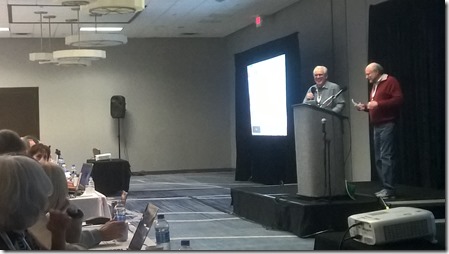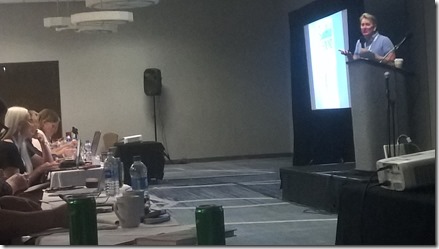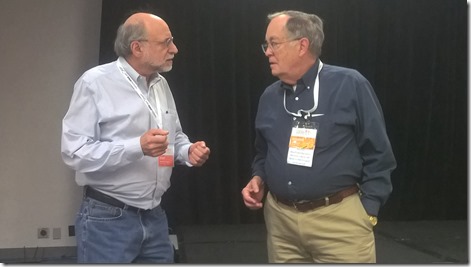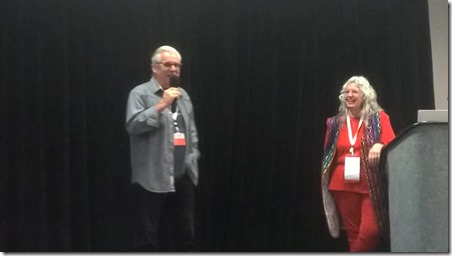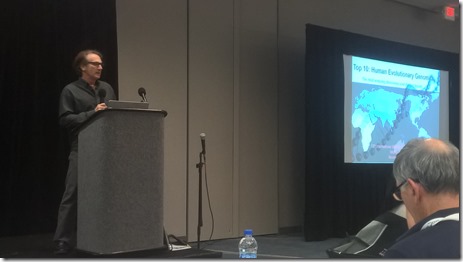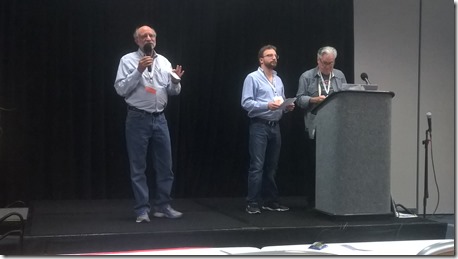The day began with Max Blankfeld and Bennett Greenspan greeting the entire group. After honoring the veterans, and there must have been 50 in the room who stood to loud applause, they provided a bit of information about the conference. There are 240 in attendance. About 50 people, including myself, raised their hands as first timers. FTDNA currently has about 140 employees with many assisting with the Conference.
Peter Sjolund, http://www.dnaacademy.se/, the ISOGG Regional Coordinator for Sweden, next presented information about the Swedish Haplogroup Database, and how Y-DNA and mtDNA tests are helping to map the genealogy of Sweden back to the 1600’s. Peter came out with a power drill and a skull. He explained that the current FTDNA method of DNA testing is inefficient and then proceeded to drill into the skull and said that this was the new way. Of course, he said, it should not be used on living persons. He told us about the research being done by DNA tests on the many old skeletons being found in the world. These are being recorded at: www.ancestraljourneys.com. Peter showed how these old skeletons are being used to trace the ancestral paths to Sweden. He recommends everyone submit their mtDNA data to the world GenBank at: http://www.tinyurl.com/mtDNAtoGenbank
At 10:15 am, Janine Cloud, the do-everything person for Family Tree DNA, presented “GAP Guidelines and You” – rules for Groups Projects Managers to follow. Basically, have fun and be nice. Janine says that some days, enforcing the GAP guidelines is like herding cats, or maybe sheep. There are almost 10,000 FTDNA projects now, managed by 8,000 Admins and Coadmins.
At 11 am, Frank Billingsley, a Houston TV weatherman, presented the story in his book “Swabbed and Found”. Frank was adopted and didn’t know who his parents were, and this was the story of his DNA journey to find them. This was the book that every attendee received free in their registration package. Frank’s presentation was very interesting and his story has many twists. He said: “The book is funny like me and cute like me. It reads like a Hardy Boys book. I hope you read it.” I waited with many others to get my copy personally signed by Frank. I look forward to reading it on the plane ride home after the Conference.
Frank’s book, Swabbed and Found, is available at Amazon:
Family Tree DNA provided a nice buffet lunch.
The afternoon started with a couple of breakout session with 3 choices. For the first session, I chose to listen to Jim Bartlett with “Specific Steps to Success with Autosomal DNA”. He started by asking how many people here have taken an autosomal test. Everyone put up their hand. He said 5 years ago, only 5 or 6 hands went up. Jim is retired and puts maybe 8 hours a day into mapping his DNA and he’s now mapped about 98% of it. See Jim’s fantastic website that I consider my bible of autosomal DNA analysis techniques at: www.segmentology.org
In the 2nd breakout session, I heard Roberta Estes talk on “Nine Autosomal Tools at Family Tree DNA & How to Use Them”. She gave all sorts of tips about less known features at FTDNA. She mentioned that Shared Origins can show matches by ethnicity. Profiles can show hidden information. Be sure to click on the “+” as well. Roberta talked about triangulation towards the end of her talk.
At 3:20, we went back to a single session. Dr. Michael Hammer presented “Top 10 Human Evolutionary Genomics”. Dr Hammer was the person that Bennett 18 years ago asked to do a DNA test for him … and the rest is history. Michael explained that humans today do not make up different subspecies or races because we only have a FST (a measure of population differentiation) of 15%. To be different races, 25% or more is needed. Neanderthal would be a different subspecies if it existed today, but humans are similar. His example was to show us photos of different people, and to see if we could place them as to where in the world they would come from, and no one got the majority correct. He gave a few interesting facts: Every individual has on average 100 DNA mutations. Fathers give 4 mutations for every 1 mothers give. And the number of mutations grow as the father is older. So “watch out for old men”. He also talked about the Clint Eastwood effect, which is 7 children starting at age 34, ending at age 66, with 5 women.
Jim Brewster and Michael Sager then told the crowd about FTDNA’s Y-Haplotree & SNP Pack Update. Then Max, Bennett and Elliot answered any and all questions about anything to do with Family Tree DNA. The loudest laugh was when Bennett meant to say “The full mt” but by mistake said “The full Monty”.
For supper, I joined a group of about 25 Jewish FTDNA group administrators who were attending the conference. Many of them I had met for the first time at IAJGS in Orlando last July. It was nice to get together again.
Picture by Adam Brown reprinted with his permission:
Following supper, there was an ISOGG reception downstairs with about 50 people still there when I got there. I finished the evening off with a really nice talk with Tim Janzen. Earlier in the day I had great talks with David Pike, Goran Runfeldt, Janet Akaha and Mags Gaulden. And Brock Shamberg and I had a wonderful talk on stock market investing.

